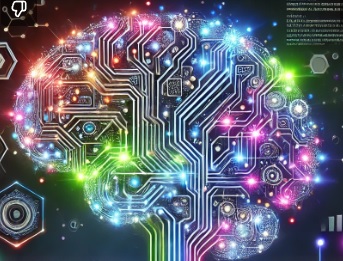ChatGPT is an AI model focused on understanding and generating natural language text, developed by OpenAI. Below is an overview of its origins, major investments, its history, and how it has evolved over time.
1. Origins of OpenAI and Context
Founding of OpenAI (2015)
OpenAI was founded in 2015 by a group of entrepreneurs and researchers, including Elon Musk, Sam Altman, Greg Brockman, Ilya Sutskever, and Wojciech Zaremba, with the aim of advancing and developing “friendly” AI for the benefit of humanity. Initially structured as a non-profit entity, it later adopted a hybrid (for-profit and non-profit) model to facilitate large-scale investments.
Main Mission
OpenAI’s stated goal is to develop AI technologies in a safe and transparent way, encouraging collaboration with the scientific community.
2. History of OpenAI’s Language Models
Before ChatGPT, OpenAI developed a series of language models known as GPT (Generative Pre-trained Transformer):
GPT-1 (2018)
- The first model in the GPT family. It demonstrated that pre-training on large amounts of text, followed by task-specific fine-tuning, could yield promising results in Natural Language Processing (NLP).
GPT-2 (2019)
- Garnered attention for its high capacity to generate coherent text. Initially, OpenAI hesitated to release the full version due to concerns about potential misuse, but eventually made the model accessible in a gradual manner.
GPT-3 (2020)
- A significant leap forward with 175 billion parameters. It became known for its impressive capability in understanding and generating text in multiple languages, and for performing various tasks (translations, Q&A, basic code generation, etc.) based on simple prompts.
GPT-3.5 and ChatGPT (late 2022)
- In the second half of 2022, OpenAI introduced improvements to GPT-3, culminating in ChatGPT (based on GPT-3.5). ChatGPT was released publicly as a prototype in late November 2022 and quickly went viral due to its coherent responses and easy-to-use chat interface.
GPT-4 (2023)
- Later, OpenAI introduced GPT-4 as an even more powerful version. Integrated into ChatGPT Plus (a subscription service) and other solutions, GPT-4 provides superior performance in terms of contextual understanding, creativity, and accuracy compared to previous models.
3. The Creation of ChatGPT
ChatGPT is a specialized instance of the GPT family, optimized for:
- Understanding conversational context.
- Producing more natural responses in a chat format.
- Handling iterative user interactions and follow-up questions effectively.
Training Techniques
ChatGPT is trained on large volumes of text from the internet (books, articles, websites). Additionally, OpenAI adopted a method called Reinforcement Learning from Human Feedback (RLHF), where researchers provide human feedback to the model to reduce bias or errors, improve its ability to follow instructions, and avoid inappropriate responses.
Popularity and Feedback
Since its release in November 2022, ChatGPT quickly amassed millions of users worldwide. Its popularity has led to a positive feedback loop: users test the model with questions, and OpenAI gathers data to further refine and improve it.
4. Investments and Partnerships
Initial Investments
At its founding (2015), OpenAI received financial backing from various investors, including Sam Altman, Elon Musk, and other Silicon Valley supporters.
Microsoft
- In 2019, Microsoft invested $1 billion in OpenAI, forging a strategic partnership that included using Microsoft Azure’s cloud services to train large-scale models.
- In 2023, Microsoft announced another massive investment (reportedly $10 billion, according to unofficial sources) to strengthen its collaboration with OpenAI, integrating GPT-based technology into its products (for example, Office services, Bing Chat, GitHub Copilot, etc.).
Other Investors
Beyond Microsoft, OpenAI attracts a wide range of investors and partners thanks to its reputation in the AI field and its innovative solutions based on large language models. Although the company maintains a non-profit section (OpenAI LP), it also has a “capped-profit” structure to secure funding and support high-cost computational research.
5. Evolution and Future Outlook
Application Expansion
ChatGPT is already being used in areas such as:
- Customer support (automated responses to frequently asked questions).
- Education and training (tutoring or generating educational content).
- Software development (code suggestions).
- Content creation (articles, summaries, copywriting).
Research and Safety
OpenAI continues to focus on improving the safety and transparency of AI, working to prevent the spread of misinformation or harmful content. Researchers and industry players collaborate to define policies for responsible AI use.
Future Developments
It is expected that OpenAI and its competitors in the AI space (Google, Meta, Anthropic, among others) will continue the race for increasing model capacity and optimizing costs for increasingly powerful and specialized models. The industry is also investing in multimodal tools (text, images, audio, video) and new, more intuitive human-machine interfaces.
6. Conclusion
ChatGPT is the result of years of research in generative language models at OpenAI. Backed by substantial investments (particularly from Microsoft) and technological innovation, it has become one of the most widely discussed and adopted AI tools worldwide. Its natural text generation capabilities, versatility, and continuous refinement (through learning techniques and human feedback) make it a major driver in the ongoing AI revolution.
ChatGPT’s impact will likely continue to expand, influencing domains such as education, research, business, and entertainment, while further pushing the boundaries of Natural Language Processing.


